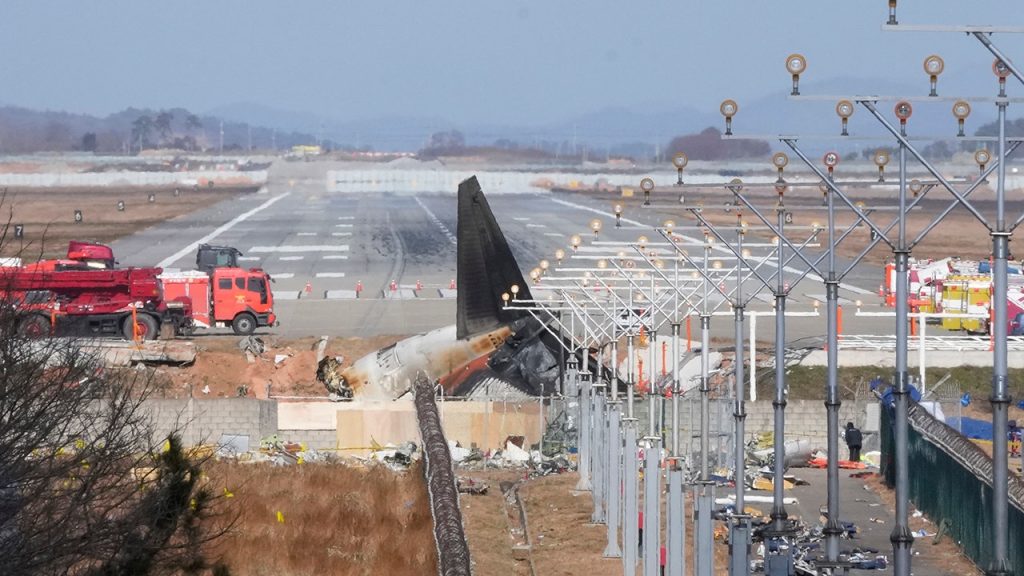Unraveling the Jeju Air Tragedy: A Preliminary Investigation
The skies over South Korea darkened on December 29, 2024, as Jeju Air Flight [Flight Number], a Boeing 737-800 en route from Bangkok, met a tragic end at Muan International Airport. Carrying 181 souls, predominantly South Korean nationals with two Thai citizens, the aircraft skidded off the runway, impacting a concrete barrier and erupting into flames. The catastrophic event claimed the lives of 179 passengers and crew, leaving only two survivors to recount the harrowing experience. A preliminary report released by South Korea’s Aviation and Railway Accident Investigation Board (ARAIB) on Monday sheds light on the series of events leading to the disaster, though the ultimate cause remains shrouded in uncertainty.
Central to the investigation are the aircraft’s "black boxes"—the flight data recorder (FDR) and cockpit voice recorder (CVR)— crucial pieces in reconstructing the final moments of the flight. Disturbingly, the ARAIB report confirms that both recorders ceased functioning approximately four minutes before the crash, a fact initially reported by the South Korean Transportation Ministry. This critical data gap complicates the investigation, leaving a void in the timeline just as the aircraft approached its final, fatal descent. The devices were subsequently sent to the United States’ National Transportation Safety Board (NTSB) for in-depth analysis, but the reason for their premature shutdown remains an enigma.
While the black boxes fell silent, other clues emerged from the wreckage. The ARAIB report documented traces of bird strikes on both engines, including feathers and bloodstains. DNA analysis confirmed the remains belonged to Baikal teals, a migratory duck species. The presence of bird remains raises the possibility of a bird strike contributing to the crash, although the exact nature of its involvement requires further investigation. Air traffic control recordings reveal that controllers had warned the pilots about potential bird activity in the area just two minutes before the aircraft issued a distress signal, confirming a bird strike. The pilots then attempted an emergency landing, which tragically ended in disaster. A security camera also captured the aircraft in close proximity to birds during an earlier, aborted landing attempt.
The landing gear’s failure to deploy emerges as another critical factor in the sequence of events. The preliminary report indicates that the pilots observed a flock of birds while approaching the Muan airport runway. Following the bird strike confirmation and the distress call, the aircraft attempted the emergency landing. However, the landing gear did not deploy, leading to the aircraft skidding off the runway upon touchdown and the subsequent collision with the concrete barrier. The impact triggered a devastating fire and explosion, engulfing the aircraft in flames.
The ongoing investigation will delve into a complex web of potential factors. The ARAIB plans to meticulously disassemble the aircraft’s engines for a comprehensive component examination. Furthermore, the available black box data, truncated as it may be, will undergo rigorous analysis alongside air traffic control communications. The investigation will also encompass the characteristics of the embankment where the aircraft ultimately came to rest, the functionality of the localizer (a navigational aid assisting pilots in aligning with the runway), and the accumulating evidence related to the bird strike. This multi-pronged approach aims to piece together the chain of events and determine the root cause of the tragedy.
The preliminary report has been shared with relevant international bodies, including the International Civil Aviation Organization (ICAO), Thailand, the United States, and France, reflecting the international nature of the investigation. The aircraft’s American manufacture and French-made engines necessitate the involvement of these nations in the process. The search for answers continues, as investigators work tirelessly to provide closure to the families of the victims and prevent similar tragedies in the future.
The scope of this disaster extends beyond the immediate loss of life, touching upon critical aspects of aviation safety and the complex interplay of mechanical systems, human actions, and environmental factors. The silencing of the black boxes four minutes before impact raises questions about the reliability of these crucial recording devices and underscores the need for continuous improvement in aviation technology. The confirmed presence of bird remains prompts further examination of bird strike prevention measures at airports and the procedures pilots follow when encountering avian hazards. And the failure of the landing gear to deploy necessitates a close scrutiny of the aircraft’s maintenance records and the overall integrity of its mechanical systems.
The investigation faces formidable challenges, primarily the significant data gap caused by the black boxes ceasing to record. This gap makes it difficult to reconstruct the precise sequence of events leading to the crash and to understand the pilots’ actions in the crucial final moments. Determining the precise role of the bird strike also poses a challenge. While evidence confirms the presence of bird remains, it is crucial to establish whether the strike directly caused the landing gear malfunction or merely contributed to a cascade of events that ultimately led to the crash.
Further complicating the investigation is the destruction of the aircraft by fire. The intense heat and flames may have compromised critical evidence, making it harder to determine the exact cause of the landing gear failure and other potential contributing factors. The involvement of multiple international entities, while necessary, can also introduce logistical challenges and potentially prolong the investigation. Despite these obstacles, the ARAIB, in collaboration with international partners, remains committed to a thorough investigation.
The Jeju Air crash serves as a stark reminder of the inherent risks in air travel and the importance of continuous vigilance in maintaining aviation safety standards. The preliminary report provides an initial glimpse into the complexity of the tragedy, but the full story will only emerge after a meticulous and comprehensive investigation. The findings will be critical not only for providing closure to the grieving families but also for informing future safety protocols and preventing similar tragedies from occurring.

